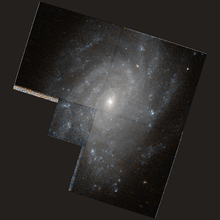
NGC 5921 is a barred spiral galaxy located approximately 65 million light-years from the Solar System in the constellation Serpens Caput. It was discovered by William Herschel on 1 May 1786. In February 2001 a type II supernova was discovered in NGC 5921. It is a member of the Virgo III Groups, a series of galaxies and galaxy clusters strung out to the east of the Virgo Supercluster of galaxies.

NGC 4984 is an intermediate lenticular galaxy exhibiting a double ring structure in the constellation Virgo. It is a member of the NGC 4856 Group of galaxies, which is a member of the Virgo II Groups, a series of galaxies and galaxy clusters strung out from the southern edge of the Virgo Supercluster. In December 2011, supernova 2011iy was discovered in it.

NGC 5247 is a face-on unbarred spiral galaxy located some 60 million light years away in the constellation Virgo. It is a member of the Virgo II Groups, a series of galaxies and galaxy clusters strung out from the southern edge of the Virgo Supercluster. This is a grand design spiral galaxy that displays no indications of distortion caused by interaction with other galaxies. It has two spiral arms that bifurcate after wrapping halfway around the nucleus. The disk is estimated to be 4.9 ± 2.0 kly (1.5 ± 0.6 kpc) in thickness and it is inclined by roughly 28° to the line of sight.
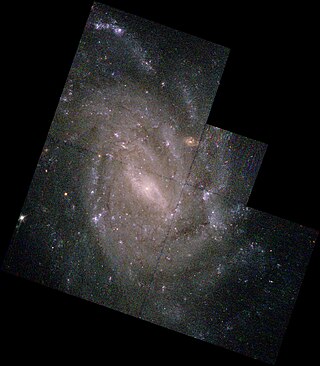
NGC 5334 is a face-on spiral galaxy in the constellation Virgo. It is a member of the Virgo III Groups, a series of galaxies and galaxy clusters strung out to the east of the Virgo Supercluster of galaxies.

NGC 5364 is a grand design spiral galaxy located 54.5 million light years away in the constellation Virgo. It is inclined to the line of sight from the Earth at an angle of 47° along a position angle of 25°. It is a member of the NGC 5364 Group of galaxies, itself one of the Virgo III Groups strung out to the east of the Virgo Supercluster of galaxies.

NGC 5792 is a barred spiral galaxy about 70 million light-years away in the constellation Libra. There is a magnitude 9.6 star on the northwestern edge of the galaxy. It was discovered on April 11, 1787 by the astronomer William Herschel. It is a member of the Virgo III Groups, a series of galaxies and galaxy clusters strung out to the east of the Virgo Supercluster of galaxies.

NGC 4420 is an unbarred spiral galaxy located 77 million light-years away in the constellation Virgo. It is a member of the M61 Group of galaxies, which is a member of the Virgo II Groups, a series of galaxies and galaxy clusters strung out from the southern edge of the Virgo Supercluster.
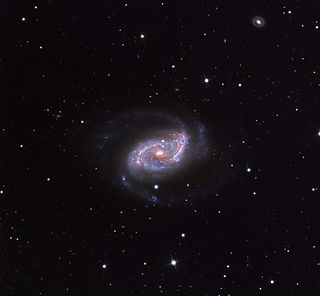
NGC 5248 is a compact intermediate spiral galaxy about 59 million light-years away in the constellation Boötes. It is a member of the NGC 5248 Group of galaxies, itself one of the Virgo III Groups strung out to the east of the Virgo Supercluster of galaxies. Distance measurements to NGC 5248 vary from 41.4 million light-years to 74.0 million light-years, averaging about 58.7 million light-years.
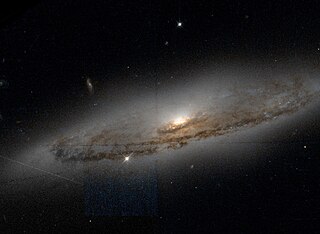
NGC 4845 is a spiral galaxy located in the constellation Virgo around 65 million light years away. The galaxy was originally discovered by William Herschel in 1786. It is a member of the NGC 4753 Group of galaxies, which is a member of the Virgo II Groups, a series of galaxies and galaxy clusters strung out from the southern edge of the Virgo Supercluster.

NGC 4517 is a spiral galaxy located approximately 40 million light-years away in the constellation of Virgo. It was discovered in 1784 by William Herschel. It is a member of the Virgo II Groups, a series of galaxies and galaxy clusters strung out from the southern edge of the Virgo Supercluster.
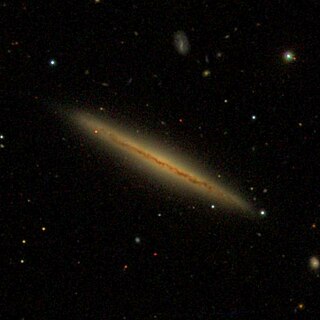
NGC 5470 is an edge-on spiral galaxy located between 43 and 68 million light-years away in the constellation Virgo. It was discovered by astronomer John Herschel in 1830. It is a member of the Virgo III Groups, a series of galaxies and galaxy clusters strung out to the east of the Virgo Supercluster of galaxies.
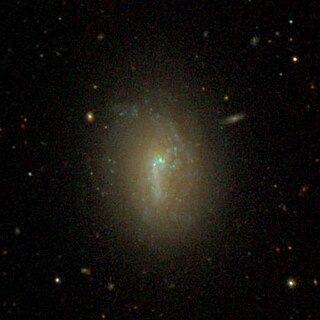
NGC 4630 is an irregular galaxy located about 54 million light-years away in the constellation of Virgo. NGC 4630 was discovered by astronomer William Herschel on February 2, 1786. NGC 4630 is part of the Virgo II Groups which form a southern extension of the Virgo Cluster.

NGC 4753 is a lenticular galaxy located about 60 million light-years away in the constellation of Virgo. NGC 4753 was discovered by astronomer William Herschel on February 22, 1784. It is notable for having distinct dust lanes that surround its nucleus. It is a member of the NGC 4753 Group of galaxies, which is a member of the Virgo II Groups, a series of galaxies and galaxy clusters strung out from the southern edge of the Virgo Supercluster.

NGC 5363 is a lenticular galaxy located in the constellation Virgo. It is located at a distance of circa 65 million light years from Earth, which, given its apparent dimensions, means that NGC 5363 is about 100,000 light years across. It was discovered by William Herschel on January 19, 1784. It is a member of the NGC 5364 Group of galaxies, itself one of the Virgo III Groups strung out to the east of the Virgo Supercluster of galaxies.
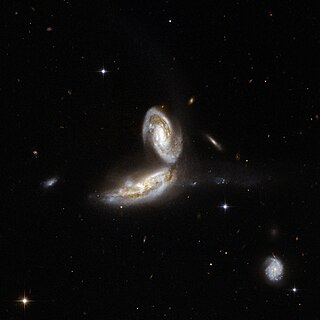
NGC 5331 is a pair of two interacting spiral galaxies in the constellation Virgo. They were discovered by William Herschel on May 13, 1793.
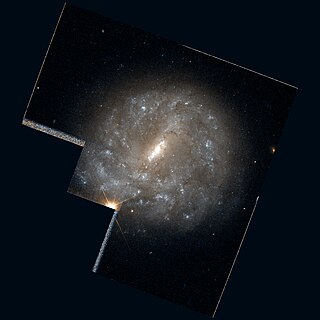
NGC 4900 is a barred spiral galaxy in the constellation Virgo. It was discovered by William Herschel on April 30, 1786. It is a member of the NGC 4753 Group of galaxies, which is a member of the Virgo II Groups, a series of galaxies and galaxy clusters strung out from the southern edge of the Virgo Supercluster.

NGC 4781 is a barred spiral galaxy in the constellation Virgo. It was discovered by William Herschel on Mar 25, 1786. It is a member of the NGC 4699 Group of galaxies, which is a member of the Virgo II Groups, a series of galaxies and galaxy clusters strung out from the southern edge of the Virgo Supercluster.

NGC 4546 is a lenticular field galaxy located in the direction of the constellation Virgo, with a total population of globular clusters estimated at about 390. It is a member of the Virgo II Groups, a series of galaxies and galaxy clusters strung out from the southern edge of the Virgo Supercluster.

NGC 5384 is a lenticular galaxy in the constellation Virgo. It was discovered on May 8, 1864, by the astronomer Albert Marth. It is located about 250 million light-years away.

The Virgo III Groups, or Virgo III Cloud, are a series of at least 75 galactic clusters and individual galaxies stretching approximately 40 megalight-years off the eastern edge of the Virgo Supercluster. Parts of it are in the constellations Virgo, Libra, and Serpens Caput. It is located approximately 65 Mly (19,929,090.60 pc) to 85 Mly (26,061,118.47 pc) from the Solar System, at a right ascension of 13h 30m to 15h 20m.
